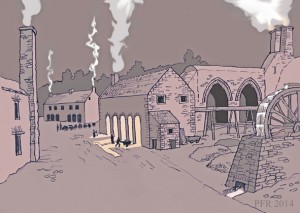The Dukesfield lead smelting mill was in operation from around 1666 until 1835. Located between the lead veins of the high Pennine hills and the markets and wharves of Newcastle it was central to the lead mining, smelting and trading business owned by generations of the Blackett and Beaumont families. Lead was a dull, grey, malleable, waterproof but highly versatile metal, used in roofing, plumbing, and shot, and refined for glassmaking, paint, and silver. Our project, and this historical summary, are focused on Dukesfield Mill and on the business it formed part of. However, because Dukesfield was probably the largest such mill in the region for a century or more, there is wider relevance for the North Pennines industry as a whole.
 Sir William Blackett, 1621-80, reproduced by kind permission of Sir Hugh Blackett
Sir William Blackett, 1621-80, reproduced by kind permission of Sir Hugh Blackett
Dukesfield mill was the first to be established by William Blackett, already a successful Newcastle merchant by the time he turned to lead mining around 1660. The regional lead industry as a whole appears to have grown enormously in the last decades of the 17th century, with Blackett – and his equally capable son Sir William II from 1680 – in the vanguard. By 1700 William II was mining throughout Allendale and in Weardale, and by then Dukesfield had probably been joined by his other two mills at Rookhope and Allenheads. An enduring pattern of ore carriage by packhorse from mines to the mills, and of pieces of lead by packhorse and two wheeled carts onwards to the navigable reaches of the Tyne at Blaydon was in place by the 1670s. So too were the key elements of a management structure needed to co-ordinate logistics and operations over 40 miles of difficult country, and sell the end product: a chief agent or steward, normally based in Newcastle, and subagents in charge of the mines and the mills.
 Illustrative reconstruction of Dukesfield Smelt Mill c.1800, copyright Peter Ryder, 2014
Illustrative reconstruction of Dukesfield Smelt Mill c.1800, copyright Peter Ryder, 2014Under the Beaumonts, Dukesfield reached its peak of activity during a boom in the Napoleonic War years. The Allen Mill below Catton was taken on in 1795 to add more smelting and silver refining capacity, and full advantage was taken of turnpike roadbuilding to improve transport links. The opening of roads in Allendale in the 1820s left Dukesfield relatively isolated and when further smelting capacity became available at Blagill Mill, Langley in 1835 – and the railway opened between Hexham and Blaydon – the mill was closed.


